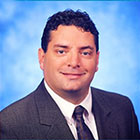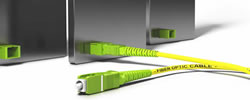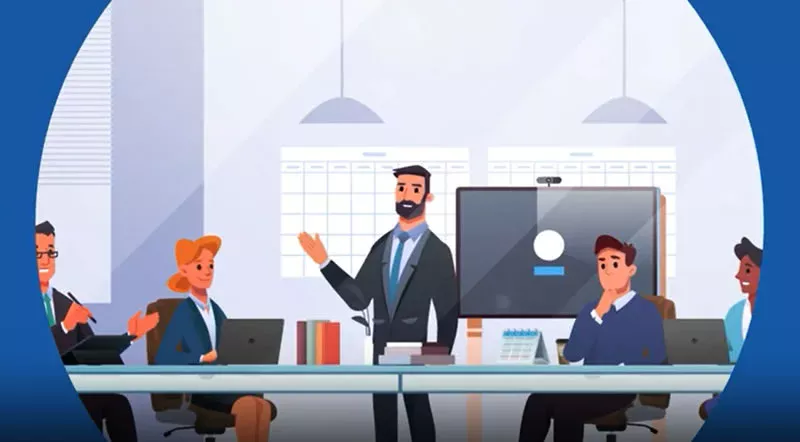Broadband Linkup
How Technology is Improving the Broadband User Experience
“Internet is the key to everything in this business, because everything flows through it.”

Chris Boring
VP, Sales and Marketing, Promptlink Communications
Communications have fundamentally changed since the implementation of broadband services; today, customer expectations are that communication is instant and clear.
“Internet is now the key to this business because everything flows through it. Whether it’s the phone or video or internet,” Chris Boring, vice president of sales and marketing at Promptlink Communications, said. This standard for speed has made broadband companies more all-encompassing but also forced them to provide new offerings to customers to stay competitive. “What it’s changed is, from an operator’s standpoint, it has completely changed their business model because as they’ve gone from what in 1995 we were, which was a pure video solution, to an internet provider and phone provider,” Boring said. “Without these innovations for the cable side of the business in DOCSIS, this never could happen. It’s completely transformed how people access content in their homes and how operators have to design their networks and their day-to-day activities.”
Boring has been involved in broadband for close to 25 years and spoke to MarketScale about the effect of technology-led change to broadband business, some of the standard issues he has experienced over the years and how he would guide the industry to improve it.
[Sean Heath]
0:14-0:50
Welcome to MarketScale Software & Technology. I’m your host Sean Heath. Now, I’m enough to remember what a dial-up modem sounded like and I do have clear recollections of how the world changed when broadband hit the scene. But that was just from a customer standpoint. I cannot imagine the excitement that my guest today experienced when he first installed broadband and he was at the vanguard. I’m not even kidding about that. Today’s guest the Vice-President of Sales and Marketing for Promptlink Communications, Chris Boring. Chris, how are you today?
[Chris Boring]
0:50-0:53
I’m good, Sean. How are you?
[Sean Heath]
0:53-1:00
I’m doing very well. Now I want to clarify. I was not saying that you are old. I was saying that you experienced. I want to get that out there.
[Chris Boring]
1:00-1:05
I appreciate that. I think I qualify in both, but I’ll take whatever you give me.
[Sean Heath]
1:05-1:19
With that experience, I’m going to go ahead and ask you just from the beginning. Talk to me about that first day because you really were implementing broadband from day one, I guess it was probably, what, around ’95?
[Chris Boring]
1:19-2:00
Yeah. It was about 1995. I was working at Cox Cable here in San Diego where I still based. And we were rolling out broadband in what was the second largest market for Cox Cable and we had a series of customer launch events where we got to watch everybody’s faces as they… as you say went from the crazy AOL dial-up to something that was just incredible in the pure speed and instant response that they got from broadband.
[Sean Heath]
2:00-2:29
There’s been a lot of innovations in the space since that day. They’re happening right now even as you and I are talking, somebody is coming up with the next great idea for broadband. What do you think has been more impactful from an innovation standpoint? Has it been the technological innovations from the physical mechanical side or have users change the way that they desire and demand access? It seems like there would be a balance between those two.
[Chris Boring]
2:29-4:11
Absolutely, and I think it really depends on which innovation we’re talking about. Nowadays, things like over-the-top video, what people call OTT has really changed the way both customers behave and the demand for technical innovation in order to accommodate this. But without the broadband speeds and the constant increases in these speed capabilities due to technological changes, for example in the cable world, they have a standard called DOCSIS and DOCSIS has evolved over the years. They’re currently on version 3.1. And each time that changes, the amount of speed delivered to the customer or at least the capability for delivering speed to the customer has increased.
And this over-the-top video, we’re talking about really things like Hulu and Netflix, Prime Video, and what it’s changed is from an operator standpoint, it’s completely changed their business model because they’ve gone from what in ’95 we were, which was a pure video solution to an internet provider and a phone provider. And without these innovations for the cable side of the business at least, in DOCSIS, this never could happen and it’s completely transformed how people access contents in their homes and how the operators have to design their networks in their day-to-day activities.
[Sean Heath]
4:11-4:52
There had been some industries the where the provider of the service or the commodity dictates what’s available to the consumer and they’re sort of the driving force in that relationship. But specifically with regard to broadband and you bring up the OTT and also let’s throw YouTube into the mix, it seems as if user behavior is really… that’s the overriding narrative. Users need more bandwidth. They are using the internet for so much streaming video. They’re almost forcing the industry’s hand. That’s a weird dynamic.
[Chris Boring]
4:52-5:48
Absolutely. And you know, it goes in leaps and bounds. So people realize that they have a little more bandwidth than they try. As you say, YouTube was there in the beginning. That was one of the first times that so much video started being pushed through these networks. I know in my house, if I walk by my 14-year-old daughter, she’s looking at some Minecraft video on YouTube as much as she’s doing anything else. And it’s definitely driving not just the speed but the need for quality of service and non-stop delivery of the speed. It’s become a mission-critical application whereas, you know, in the beginning if your dial-up didn’t work, “Oh, well, big deal.” It wasn’t the center of everything you were doing in your house the way it is today.
[Sean Heath]
5:48-6:04
I know this may be a bad analogy, but is trying to gain market share as a broadband provider, is it almost like the Cold War like an arms race or is everybody having a tendency to play together nicely?
[Chris Boring]
6:04-7:00
Well, it’s an interesting business because while geographically depending on the technology, it’s almost monopolistic. For example, you won’t have multiple cable operators offering service to the same customers. You will have cable operators offering service, fiber provider like a Verizon Fios or an AT&T that is offering service to the same customers or in a rural area you would have satellite internet available.
So the cable operators play nicely together because they’re not really competing but between the cable operators and the other telecom companies, there’s extreme competition and we all play nicely together, but at the same time, we recognize when we’re competitors and when we’re not.
[Sean Heath]
7:00-7:11
This is a sink or swim industry. If you don’t find a solution, your customer will do their best to find another provider. So talk to me about some of the real world challenges that you face.
[Chris Boring]
7:21-8:36
Well, for me, we I’ve transitioned from being on the cable operator site to supplying services to cable operators. So our company has two different main focuses that create different challenges. One focus for us is testing the equipment that provides the broadband access to the customers. So a cable modem in your house when it’s returned by you to the operator, it needs to be checked, tested, recycled, and made sure that it’s operating perfectly before it’s sent back out to another customer. So that’s part of our business and that has its own challenges.
On the other side, our business is also about monitoring and helping operators maintain their network connections and maintain that high speed internet that we’ve been talking about. And the challenges there are many. It’s really about giving the operators the best visibility and best perspective as to what’s happening in their network and trying to meet their pain points.
[Sean Heath]
7:11-8:44
One of the pain points that cable operators have specifically is when they have a problem being able to find that and you’re really a good detective. You really have a nose for finding problems pretty quickly. Do you find yourself doing that a lot?
[Chris Boring]
8:44-10:56
Absolutely. And the technology related to how operators find problems in their network and how they maintain that network has changed dramatically over the last 10 years. As these bandwidth demands, we’ve been talking about become greater and greater. Originally, operators had more than historical view into what happened in their networks. And without getting too technical, what we’re talking about is something called SNMP, which was a way that you could talk to different devices whether they are cable modems or whether they are other network components in the network and you could ask them to tell the status that they see, report that back, gather that information.
And in some cases, providing that meant not real time information. So why do I say that? Well, if you have a million cable modems in your network, you cannot ask a million cable modems at the same time to tell you their status because you would actually create the problem in your network that you’re trying to avoid. So instead, they do what’s called polling, and every 20 minutes or every hour they go through the population of devices and pull the device, get a response, store that that response, and then from there, there’s correlation that happens in different network management software like our cable plant monitoring product that we offer and that gives operators, at least, gave them at that point a picture of either what was happening now and more likely what was happening 20 minutes ago or an hour ago when the polling actually happened
So what that means is that unfortunately in many cases if there was an outage of some kind, they would find out not because someone was able to tell them before the phone rang, but because the phone rang, and then they checked and they saw 20 minutes ago everything was okay, but now it’s not.
[Sean Heath]
10:56-11:12
Now in a situation like this, I would imagine that one of the biggest culprits, one of the banes of your existence is network noise. Talk to me about some of the things that you guys are doing to deal with network noise.
[Chris Boring]
11:12-12:48
Well, network noise is definitely a big challenge for various reasons and some of the technology that’s changed from what we were just describing with SNMP, polling, and looking at historical data, what’s changed is that cable labs, which is the same standards body that developed DOCSIS, has come out with some new technology that has been embedded into the network devices. And one of those is called PNM which stands for Proactive Network Maintenance. And what PNM does is it monitors devices that are not currently offline, but are struggling to maintain the level of service to customers that should be there. And what we’re able to do in our software by accessing this information is to predict proactively when an outage might happen and be able to locate problems in the network that are currently at a low level but will soon be causing a major problem.
And by utilizing some of that information and also some of the traditional information we can get from talking to these devices, we have developed an algorithm to find not only that there is network noise because it’s not hard to see that there is noise. It’s hard to see where in the network it is.
[Sean Heath]
12:48-12:56
How hard is it to determine what’s causing the noise? I mean, is it necessarily about finding a physical flaw somewhere?
[Chris Boring]
12:56-14:54
It usually is. Yes. The problem is that when noise occurs in the network, it spreads from some starting point to all of the devices that are connected to that part of the network. So when you’re looking, you can’t tell which devices most affected or where the source of the problem is without doing some real magic in there. And what we do with our product, which is called Network NoiseHawk is we combine over 15 different parameters into an algorithm. We’re able to direct the cable operators to a very specific section of the network that’s very close together.
Without that, they have what are called, when we look at the transmission of signals for internet, what’s called upstream and downstream, and if you think of uploading something, uploading a file or downloading a file, it’s basically the same thing. You have different frequencies and different signals going in each direction. When there’s network noise, all of the devices on one upstream, right, one path going back to the network will be affected. And without any special tools, the cable operators end up sending trucks out, going up poles and connecting and disconnecting things until they disconnect one and all of a sudden the noise goes away.
This is a very time-consuming effort. We’ve seen situations where they work, two, three, four days with one person trying to find the problem, and it’s very expensive for the operators and it’s not too fun for the customers who continue to have service disconnected and reconnected as they try to find the problem.
[Sean Heath]
14:54-15:16
And the real culprit could be something as simple as a small nick in a cable. I mean, sometimes I guess the noise could even be coming from within the house. It could be the issue for particular customer could be coming from maybe a recycled WiFi device that their cable operator has provided to them.
[Chris Boring]
15:16-16:00
Yeah, it’s more likely not a WiFi device. It’s something even simpler. It’s a house with a splitter in the attic that is old and corroded and the cable going into it is broken and it allows signal to get into a network that’s supposed to be a closed network. The ones inside the house are a little easier to find. It’s the ones out on the plant and it can be as simple as a cable that’s bent in the wrong direction or a coupler that is loose or a signal amplifier that is bad. Any of those things can introduce noise into the network and create all kinds of havoc.
[Sean Heath]
16:00-16:16
With all of your experience chasing down these problems, I want to make you the boss for one day of broadband, period. You’re the boss of all broadband, what are one or two things that you would do immediately?
[Chris Boring]
16:16-18:00
You know, it’s a challenge for older, more established companies compared to some new companies. When you look at a cable plant today from an operator that’s been in operation for 10 or 15 years, they have millions and millions of dollars spent on equipment that really needs to be upgraded that’s in the plant. So I think the first thing, you know, I would do if I was an operator and I was the boss is make sure I allocate the right amount of budget to be able to upgrade to the latest technology but also I think provide my teams with integrated tools because what we see a lot when you look at operators, I’ll go in and talk to the CTO of the company and they will have 10 or 15 different tools that they use to diagnose issues. And those tools don’t talk to each other. They’re not integrated at any way and in some cases they give completely conflicting information.
So I think, first of all, make sure the equipment that you have is up to par. Secondly, find a way to integrate information together to get a complete picture of what’s happening and get out of the reactive mode because the reactive mode is what cost you customers. If you wait until there’s an outage or a problem or internet is slow, you’re going to lose customers and internet is the key to everything now in this business because everything flows through it, whether it’s phone or video or internet.
[Sean Heath]
18:00-18:07
Is there a specific project that you’ve worked on and when you are finished you thought, “I can’t believe we made that work”?
[Chris Boring]
18:07-19:33
Well, the network noise problem has been around since 1995 when we started because it stops everything from working and it’s so elusive when you’re out there. You’ll have a time where you go, you find a noise problem, when you go out to try to fix it, and by the time you get out there, it’s gone. Some of the craziest things we found, we’ve gone out working with the cable operators, we’ll send a team out when we do a deployment of our software. We’ll send our own team out to work with the operators to show them how to use the tools. And we had a crazy one where there was a mall and they for weeks were trying to find the noise in the mall, they couldn’t find it. It would be there and then they would send somebody out when the mall was closed and the problem would be gone. And this went on day after day after day.
Finally, we were able to do some historical tracking of the noise, which was a tool they didn’t have access to previously, and we saw the reason they couldn’t find it. There was a particular store in the mall and every time they turned on their overhead lights it created noise in the network because there was a break in the cable in the ceiling there.
So you go after hours, it’s gone. They went during hours, went right to the store, opened it right up, and fix the problem instantly. It was amazing.
[Sean Heath]
19:33-19:48
As a man who has literally been wired for going on 25 years, you have been connected to the internet non-stop for 25 years. How many days could you survive off the grid when you go on vacation?
[Chris Boring]
19:48-19:52
You know, right now I think I could probably survive a couple of weeks.
[Sean Heath]
19:52-19:53
Really?
[Chris Boring]
19:53-19:59
And off the grid, meaning? Well, define off the grid because fully off the grid.
[Sean Heath]
19:59-20:03
By off the grid, I mean you are out of touch, no emails, no projects.
[Chris Boring]
20:03-20:15
If I’m on a beach somewhere Sean or I’m on a boat and I can go fishing, hiking, whatever every day, I could probably do it for a couple of weeks, but I might be cheating a look here and there.
[Sean Heath]
20:15-20:24
Well, you know, here’s the thing, you’ve made yourself indispensable, which is the true hallmark of a good employee is someone who makes himself necessary.
[Chris Boring]
20:24-20:27
Well, let’s hope that’s true. I do my best.
[Sean Heath]
20:27-20:34
You know what? If you don’t tell people that I’m faking it, I won’t tell people that you’re faking it.
[Chris Boring]
20:34-20:50
No. I really love the business obviously as long as I’ve been at it. It’s exciting. I’m a marketing and sales VP, but I’m an engineer at heart. I love everything technological. I love playing with it. I love just everything about it. So I appreciate it.
[Sean Heath]
20:50-21:09
Well, you have actually solved some questions that I had. So mission accomplished. Well done you. Today, it has been my pleasure to have a conversation with the Vice-President of Sales and Marketing for Promptlink Communications, Chris Boring. Chris, thank you so much for taking the time today. I really have enjoyed this.
[Chris Boring]
21:09-21:09
Thank you, Sean. So have I. I appreciate it.

How Technology is Improving the Broadband User Experience
Chris Boring
VP, Sales and Marketing, Promptlink Communications

El mundo está más dependiente al wifi. ¿Lo podemos diagnosticar apropriadamente?
David Mosquera
Director, Latin American Sales, Promptlink Communications

More ISPs Are Offering ‘White Glove’ Wi-Fi Service for Better Consumer Experience
Chris Boring
VP, Sales and Marketing, Promptlink Communications

How to Detect Noise in Cable Communications
Foad Towfiq
CEO, Promptlink Communications

What to Watch for at SCTE Cable-Tec Expo
Chris Boring
VP, Sales and Marketing, Promptlink Communications

Cable-Tec Attendees Have Been ‘Out of Control Amazed’ with Network NoiseHawk
Foad Towfiq
CEO, Promptlink Communications

Multiple Content Streams, Single Content Pipe
Alexander "Shony" Podarevsky
Senior System Engineer, Promptlink Communications

Restauración de equipos es la estrategia rentable y ecológica para una industria de telecomunicaciones creciente
David Mosquera
Director, Latin American Sales, Promptlink Communications








